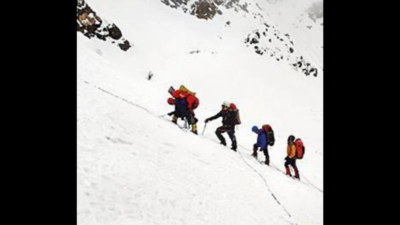Top Searches
- News
- City News
- kolkata News
- West Bengal: Expert climbers plan info camps to minimise expedition deaths
West Bengal: Expert climbers plan info camps to minimise expedition deaths

Climbers at Mt Indrasan in Kullu district of Himachal witnessed retreating glacier this year
KOLKATA: Experienced mountaineers and trekkers from Bengal have decided to organise district-level hazard awareness camps in order to minimise accidents during high-altitude expeditions, concerned with an avalanche of deaths of people from the state this year and realising that most of the accidents happened because the mountain topography was changing as a direct effect of climate change and global warming.
As many as 12 climbers and trekkers from Bengal have died this year, the most in the last six years. The toll includes four climbers who died during the advanced training camp in Uttarakhand's Uttarkashi, organised by the Nehru Institute of Mountaineering (NIM).
"The primary reason is global warming, which is causing glacier retreat and melting of ice. We witnessed the same incident at the Kilimanjaro expedition last month. The snow-capped summit of Mt Kilimanjaro is gradually disappearing, except for some permanent ice fields," said Falguni Dey, an assistant professor of geography at Women's College, Bagbazar, an avid climber. On Thursday, Unesco warned that the glaciers that cap Mt Kilimanjaro will be gone by 2050 due to global warming.
Cyclist Chandan Biswas has started organising climbers to hold awareness camps in districts. He, along with mountaineers Satyarup Siddhanta and Debashis Biswas, plan to start awareness camps for adventure sports enthusiasts soon. "We will explain how mountains are changing due to global warming. Climbers and trekkers need to take cautious steps as the mountain may not be what it was some years back," Biswas said. "Also, it is important to inform the state youth service department before setting out for the summit," he added.
Santanu Mishra, associate professor, earth science department, IIT Kanpur, said there was one more factor besides climate change and global warming that was causing glaciers to retreat and creavasses to open up. “As snow cover depletes, the mountain’s surface reflects less sunlight and more heat is absorbed. With the rocks getting exposed, they absorb more heat, resulting in further ice melt.”
Satyarup Siddhanta, a Guinness World record-holder for being the youngest mountaineer in the world — and the first from India — to climb both the Seven Summits and Volcanic Seven Summits, said climbers needed to take into account several factors. These would be just some of the things addressed in the camps. “Climbers must know how to assess chances of rainfall or snowfall by going through weather inputs from multiple sources,” he said. “They will also have to understand how the weather pattern is changing and that, in turn, impacting snowfall in the mountains.”
Only experts could provide such knowhow. “Many climbers from Bengal, who are not part of reputable clubs, go for expeditions without much preparation or experienced guides. Many of them do not have anyone monitoring their movements remotely. This has become essential, given the frequency of accidents,” Biswas said. “Despite NIM being one of the most reputable organisations, they could not avert the accident,” said Siddhanta.
For Biswas, an Everest summiteer, the increase in frequency of accidents could only mean one thing. “If you look at the larger pattern, most deaths are at the 5,000 metre-6,000 metre level, or below,” he said. “This clearly shows that the nature of the mountain, especially the Himalayas, is changing because of climate change, and that’s why avalanches are becoming more frequent.”
Siddhanta said crevices had started forming at places it was not expected to earlier.
Piyali Basak, who has given a miss to her Cho Oyu summit attempt following inclement weather, said: “It is important to assess the point beyond which one should not push further.”
As many as 12 climbers and trekkers from Bengal have died this year, the most in the last six years. The toll includes four climbers who died during the advanced training camp in Uttarakhand's Uttarkashi, organised by the Nehru Institute of Mountaineering (NIM).
"The primary reason is global warming, which is causing glacier retreat and melting of ice. We witnessed the same incident at the Kilimanjaro expedition last month. The snow-capped summit of Mt Kilimanjaro is gradually disappearing, except for some permanent ice fields," said Falguni Dey, an assistant professor of geography at Women's College, Bagbazar, an avid climber. On Thursday, Unesco warned that the glaciers that cap Mt Kilimanjaro will be gone by 2050 due to global warming.
Cyclist Chandan Biswas has started organising climbers to hold awareness camps in districts. He, along with mountaineers Satyarup Siddhanta and Debashis Biswas, plan to start awareness camps for adventure sports enthusiasts soon. "We will explain how mountains are changing due to global warming. Climbers and trekkers need to take cautious steps as the mountain may not be what it was some years back," Biswas said. "Also, it is important to inform the state youth service department before setting out for the summit," he added.
Santanu Mishra, associate professor, earth science department, IIT Kanpur, said there was one more factor besides climate change and global warming that was causing glaciers to retreat and creavasses to open up. “As snow cover depletes, the mountain’s surface reflects less sunlight and more heat is absorbed. With the rocks getting exposed, they absorb more heat, resulting in further ice melt.”
Satyarup Siddhanta, a Guinness World record-holder for being the youngest mountaineer in the world — and the first from India — to climb both the Seven Summits and Volcanic Seven Summits, said climbers needed to take into account several factors. These would be just some of the things addressed in the camps. “Climbers must know how to assess chances of rainfall or snowfall by going through weather inputs from multiple sources,” he said. “They will also have to understand how the weather pattern is changing and that, in turn, impacting snowfall in the mountains.”
Only experts could provide such knowhow. “Many climbers from Bengal, who are not part of reputable clubs, go for expeditions without much preparation or experienced guides. Many of them do not have anyone monitoring their movements remotely. This has become essential, given the frequency of accidents,” Biswas said. “Despite NIM being one of the most reputable organisations, they could not avert the accident,” said Siddhanta.
For Biswas, an Everest summiteer, the increase in frequency of accidents could only mean one thing. “If you look at the larger pattern, most deaths are at the 5,000 metre-6,000 metre level, or below,” he said. “This clearly shows that the nature of the mountain, especially the Himalayas, is changing because of climate change, and that’s why avalanches are becoming more frequent.”
Siddhanta said crevices had started forming at places it was not expected to earlier.
Piyali Basak, who has given a miss to her Cho Oyu summit attempt following inclement weather, said: “It is important to assess the point beyond which one should not push further.”
FOLLOW US ON SOCIAL MEDIA
FacebookTwitterInstagramKOO APPYOUTUBE
Start a Conversation
end of article









